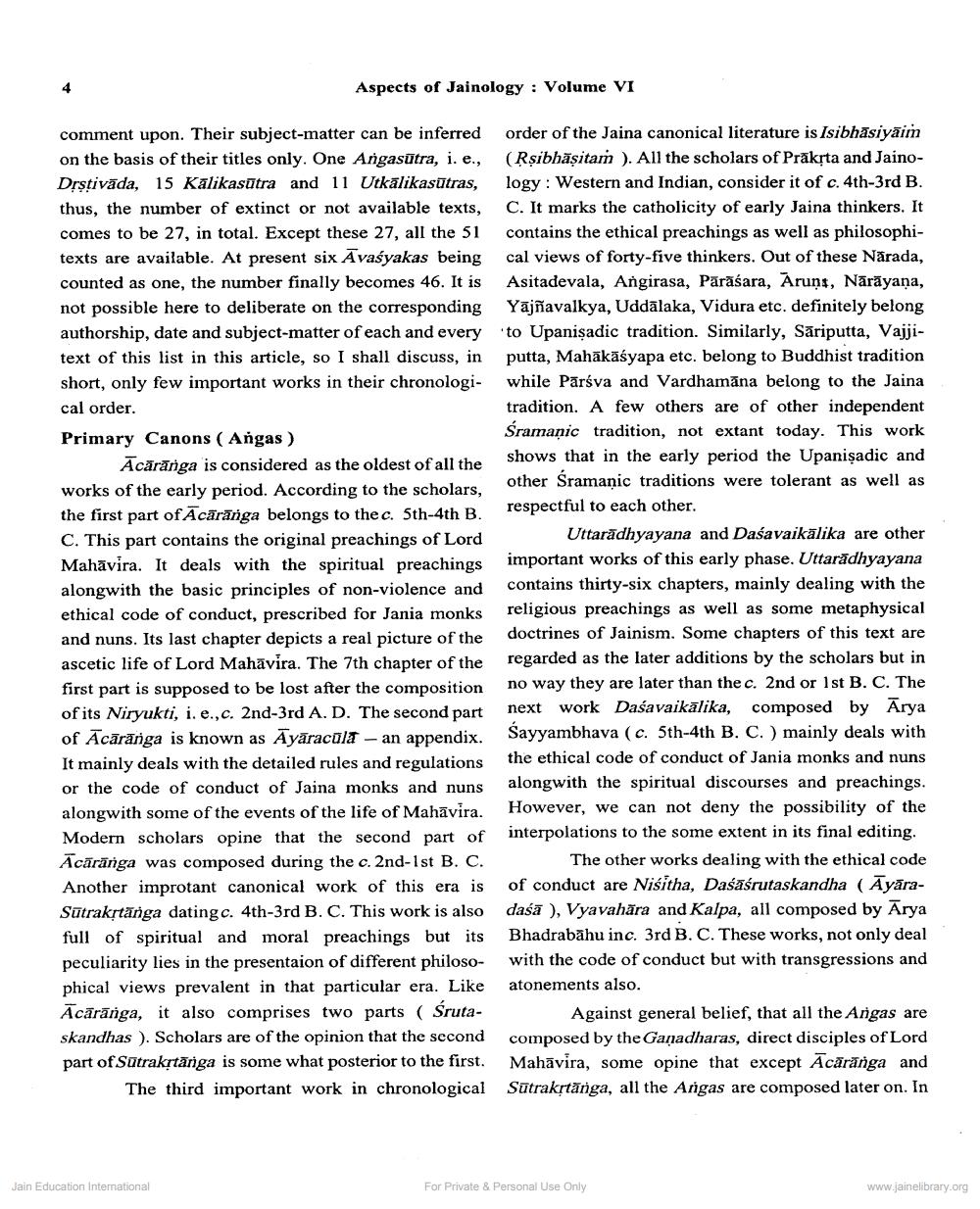________________
Aspects of Jainology : Volume VI
comment upon. Their subject-matter can be inferred order of the Jaina canonical literature is Isibhāsiyāim on the basis of their titles only. One Angasūtra, i. e., (Rşibhāṣitam ). All the scholars of Präkrta and JainoDrstivāda, 15 Kalikasūtra and 11 Utkālikasūtras, logy : Western and Indian, consider it of c. 4th-3rd B. thus, the number of extinct or not available texts, C. It marks the catholicity of early Jaina thinkers. It comes to be 27, in total. Except these 27, all the 51 contains the ethical preachings as well as philosophitexts are available. At present six Āvaśyakas being cal views of forty-five thinkers. Out of these Nārada, counted as one, the number finally becomes 46. It is Asitadevala, Angirasa, Pārāśara, Aruņs, Nārāyana, not possible here to deliberate on the corresponding Yājñavalkya, Uddālaka, Vidura etc. definitely belong authorship, date and subject-matter of each and every to Upanisadic tradition. Similarly, Sāriputta, Vajjitext of this list in this article, so I shall discuss, in putta, Mahākāśyapa etc. belong to Buddhist tradition short, only few important works in their chronologi- while Pārsva and Vardhamana belong to the Jaina cal order.
tradition. A few others are of other independent Primary Canons ( Angas )
Sramanic tradition, not extant today. This work Acārānga is considered as the oldest of all the
shows that in the early period the Upanișadic and works of the early period. According to the scholars,
other Sramanic traditions were tolerant as well as the first part of Ācārānga belongs to the c. Sth-4th B.
respectful to each other. C. This part contains the original preachings of Lord
Uttarādhyayana and Daśavaikälika are other Mahāvira. It deals with the spiritual preachings important works of this early phase. Uttarādhyayana alongwith the basic principles of non-violence and contains thirty-six chapters, mainly dealing with the ethical code of conduct, prescribed for Jania monks religious preachings as well as some metaphysical and nuns. Its last chapter depicts a real picture of the doctrines of Jainism. Some chapters of this text are ascetic life of Lord Mahavira. The 7th chapter of the regarded as the later additions by the scholars but in first part is supposed to be lost after the composition no way they are later than the c. 2nd or 1st B. C. The of its Niryukti, i.e., c. 2nd-3rd A. D. The second part next work Daśavaikālika, composed by Arya of Acārānga is known as Ayāracula - an appendix. Sayyambhava (c. 5th-4th B. C.) mainly deals with It mainly deals with the detailed rules and regulations the ethical code of conduct of Jania monks and nuns or the code of conduct of Jaina monks and nuns alongwith the spiritual discourses and preachings. alongwith some of the events of the life of Mahāvira. However, we can not deny the possibility of the Modern scholars opine that the second part of interpolations to the some extent in its final editing. Ācārānga was composed during the c. 2nd-1st B. C.
The other works dealing with the ethical code Another improtant canonical work of this era is of conduct are Niśitha, Daśāśrutaskandha (AyāraSūtrakrtānga dating c. 4th-3rd B. C. This work is also daśā ), Vyavahāra and Kalpa, all composed by Arya full of spiritual and moral preachings but its Bhadrabāhu inc. 3rd B. C. These works, not only deal peculiarity lies in the presentaion of different philoso- with the code of conduct but with transgressions and phical views prevalent in that particular era. Like atonements also. Ācārānga, it also comprises two parts ( Śruta
Against general belief, that all the Angas are skandhas). Scholars are of the opinion that the second composed by the Ganadharas, direct disciples of Lord part of Satrakrtänga is some what posterior to the first. Mahāvira, some opine that except Ācārānga and
The third important work in chronological Sūtrakrtānga, all the Argas are composed later on. In
Jain Education International
For Private & Personal Use Only
www.jainelibrary.org




